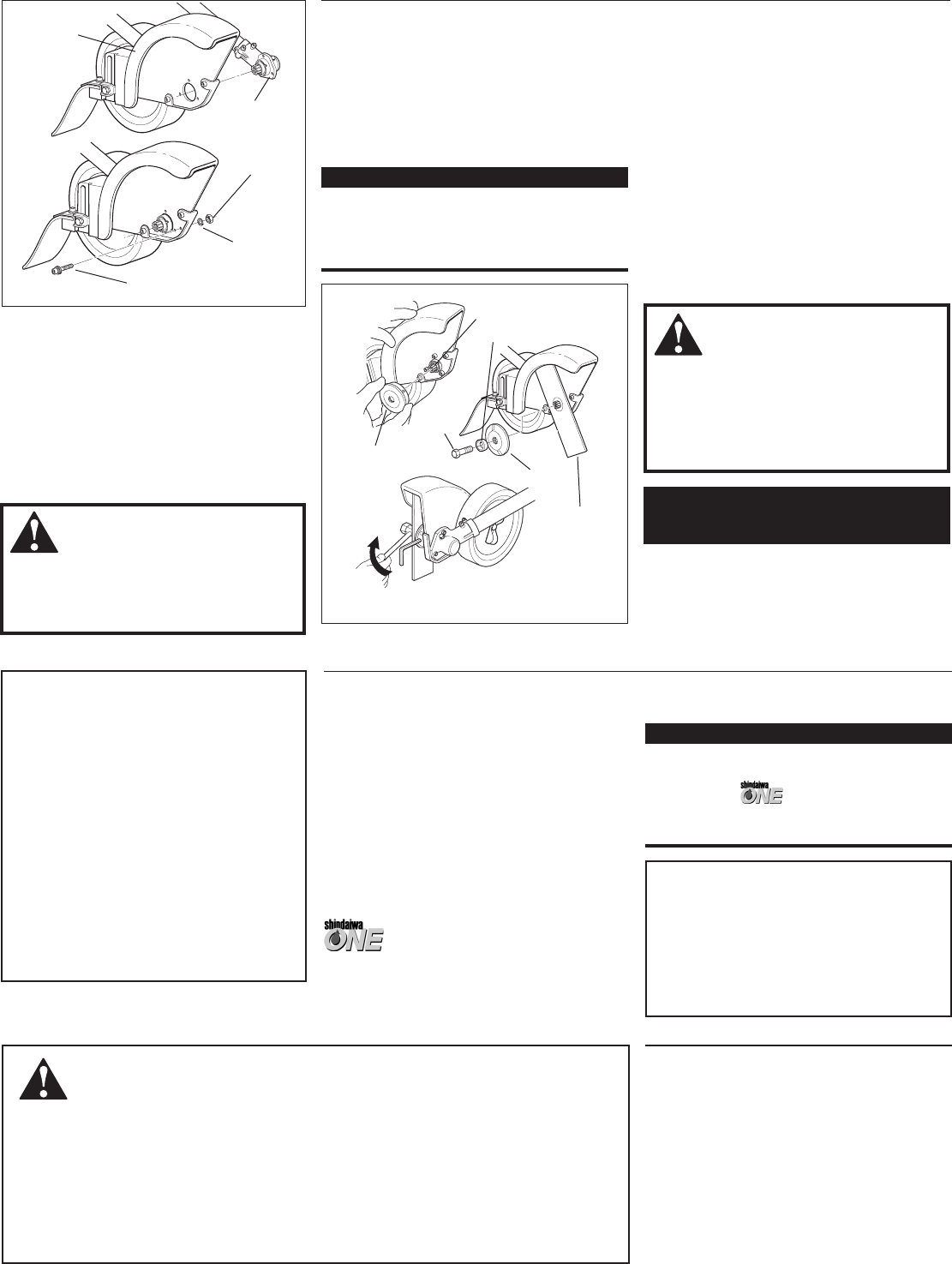
8
23031
23029
23030
Mount the Edger Blade
1. Install the holder A onto the output
shaft. See Figure 13.
2. Mount the edger blade and holder B
onto the output shaft, and then install
the bolt guard and shaft bolt (turn bolt
counterclockwise to install).
See Figure 13.
3. Align the hole in holder A with the
matched hole in the gearcase, and then
use the hex wrench to temporarily lock
the output shaft. See Figure 13.
4. Use the combination wrench to firmly
tighten the shaft bolt. Remove the hex
wrench. See Figure 13.
WARNING!
The LE231 is designed for use with
an Edger blade only!
Never operate the LE231 without
the Cutting Attachment Shield in-
stalled and tightly secured!
Mount the Cutting Attachment Shield
on the Gearcase.
1. Remove the shaft bolt, bolt guard, hold-
er A and holder B from the gearcase.
See Figure 12.
2. Align the cutting attachment shield as-
sembly with the gearcase as shown, and
then fit the shield onto the matching
flange on the gearcase. See Figure 12.
The LE231 Edger should now be
completely assembled.
Cutting
Attachment
Shield
Gearcase
Flange
Socket-head screws
and washers
Holder A
Edger
Blade
Lock the shaft
Holder B
Shaft
Bolt
Bolt Guard
Nut
Spring
Washer
Figure 13
Output Shaft
Attachment Shield and Edger Blade LE231
Assembly
WARNING!
The LE231 is intended for right-handed
operation only! When correctly assem-
bled, the cutting attachment shield and
shaft must be oriented as shown.
3. Install the socket-head screws with
washers, then use the hex wrench to
firmly tighten all three screws. See
Figure 12.
4. Install a washer and nut on each of the
three screws assembled in Step 3, then
firmly tighten each nut.
IMPORTANT
The three socket-head screws must be
firmly tightened against the cutting attach-
ment shield before installing and tightening
the nuts.
IMPORTANT!
Mix only enough fuel for your immediate
needs! If fuel must be stored longer than
30 days and oil with fuel stabilizer
is not used, it should rst be treated with a
fuel stabilizer such as STA-BIL™.
Mixing Fuel
CAUTION!
This engine is designed to operate on
a 50:1 mixture consisting of unleaded
gasoline and ISO-L-EGD or JASO FC
class 2-cycle mixing oil only. Use of
non-approved mixing oils can lead to
excessive carbon deposits.
CAUTION!
Some types of gasoline contain al-
cohol as an oxygenate. Oxygenated
gasoline may cause increased op-
erating temperatures. Under certain
conditions, alcohol-based gasoline
may also reduce the lubricating
qualities of some 2-cycle mixing oils.
Never use any type of gasoline
containing more than 10% alcohol
by volume! Generic oils and some
outboard oils may not be intended
for use in high-performance 2-cycle
type engines, and should never be
used in your Shindaiwa engine.
Use only fresh, clean unleaded gasoline
with a pump octane of 87 or higher.
Mixed with 50:1 Shindaiwa ISO-L-EGD
or JASO FC class 2-cycle mixing oil at a
gasoline/ratio of 50:1 (1 gallon of gaso-
line to 2.6 ozs mixing oil). Shindaiwa One
meets or exceeds these requirements.
Oil is a registered JASO FC classi-
fied oil and also meets or exceeds ISO-L-EGD
performance requirements. Shindaiwa One
is recommended for use in all Shindaiwa
Examples of 50:1 mixing quantities
1 gallon of gasoline to 2.6 oz. mixing oil.
5 liters of gasoline to 100 ml. mixing oil.
WARNING!
Minimize the Risk of Fire!
ALWAYS stop the engine and allow it to
cool before refueling. Avoid overlling and
wipe off any fuel that may have spilled.
Wipe all spilled fuel and move the engine
at least 10 feet (3 meters) from the fueling
point and source before restarting!
NEVER start or operate this unit if there is
a fuel leak.
Filling the Fuel Tank
NEVER start or operate this unit if the
carburetor, fuel lines, fuel tank and/or fuel
tank cap are damaged.
NEVER smoke or light any res near the
engine or fuel source!
NEVER place any ammable material
near the engine mufer!
NEVER operate the engine without the
mufer and spark arrester in good work-
ing condition.
1. Place the unit on a flat, level surface.
2. Clear any dirt or other debris from
around the fuel filler cap.
3. Remove the fuel cap, and fill the tank
with clean, fresh fuel.
4. Reinstall the fuel filler cap and tighten
firmly.
low emissions engines. Shindaiwa One also
includes a fuel stabilizer.
Figure 12


















